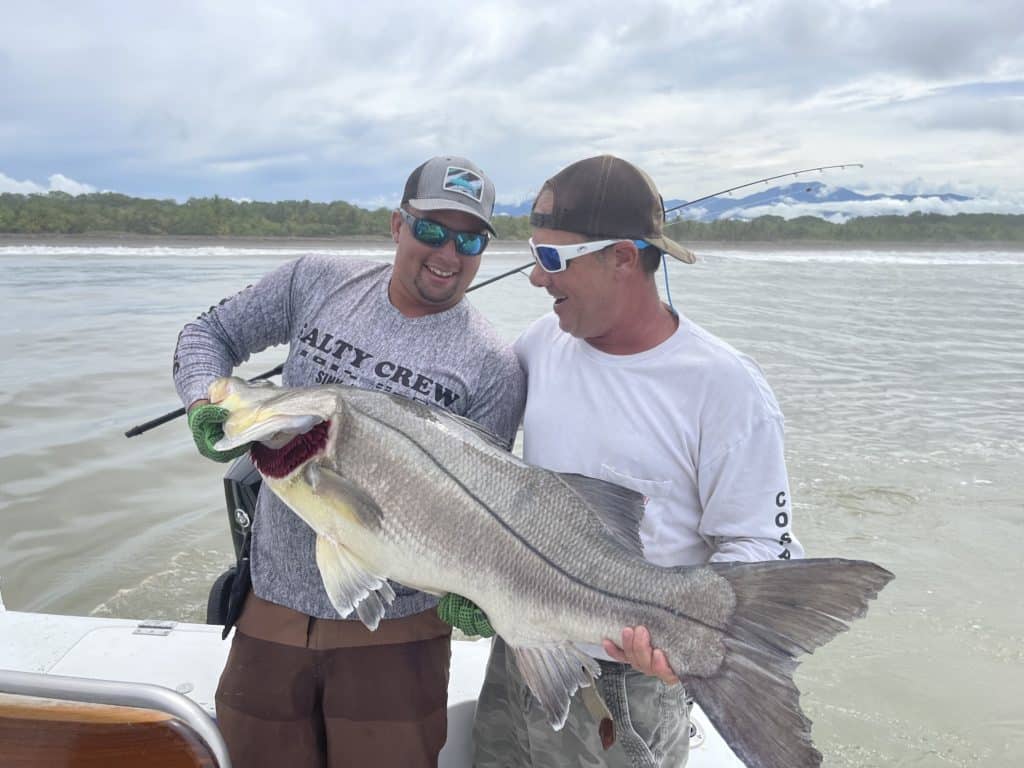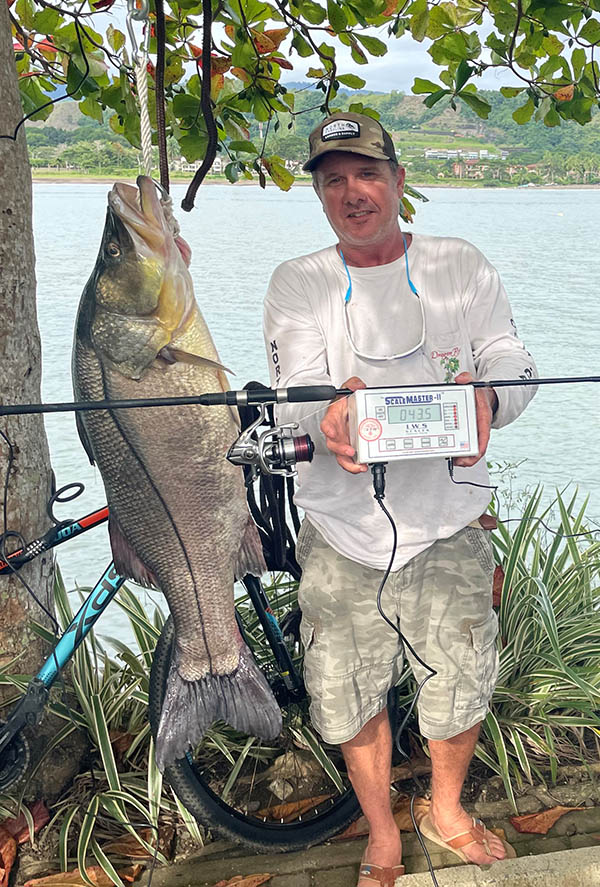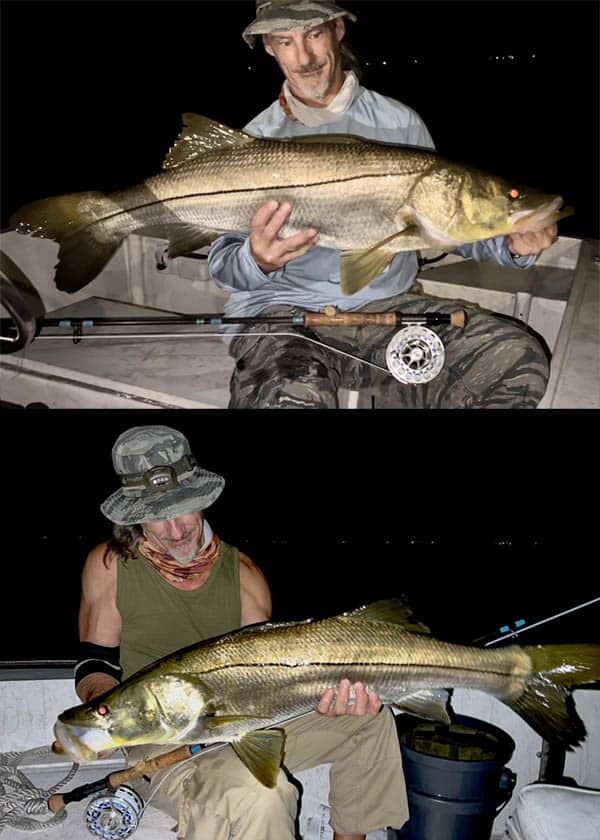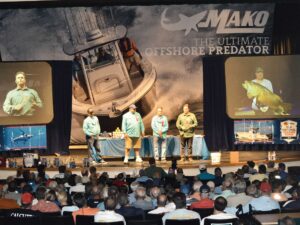
A charter captain who guided light-tackle legend Raleigh Werking to some of his four dozen IGFA world records set his own line-class mark this summer, completing a decade-long quest to catch a world-record Pacific snook (Centropomus spp.) on 6-pound line when he boated a 43.5 pounder in Costa Rica.
Capt. George Hughes Beckwith Jr., who runs Down East Guide Service in Morehead City, North Carolina, was fishing in July off Quepos, Costa Rica, where he also owns a charter boat, The Dragin Fly. He went out with Capt. Roy Zapata, his go-to choice for snook trips. Zapata has guided several anglers to world-record snook, including the all-tackle record Pacific black snook, a 59.8 pounder caught off Quepos in 2014 by Ward Michaels. Beckwith says he often tags along in hopes of setting a new 6-pound record for snook. “I’ve caught a lot of big fish with Roy on 6-pound line over the past few years,” he notes, “but I never quite got that big snook bite.”
That finally changed July 3. Using live sardines for bait, Beckwith and companions were slow-trolling tidelines parallel to the beach when one of his party caught a decent snook. Now confident that snook were nearby, they made another pass.
Dangerous Trolling Technique
The favored method for trolling snook in Costa Rica is to run parallel to the beach just outside the breaking surf. “It’s about getting as close in there as you can without getting swamped by these sets of crazy waves that can come out of nowhere,” Beckwith explains. “There’s a history of people losing boats fishing this way.” A friend of Beckwith’s always takes along a surfer when trolling for snook. “The surfer doesn’t fish; he just watches waves and says, ‘Hey, man, you guys might want to watch this set coming up.’ You look up and offshore there’s four or five waves curling up and you gotta get the hell out of there.”
Beckwith hooked what felt like “a pretty good” fish, but he wasn’t certain, at first, that it was a snook. The fish made a strong run that took about 100 yards of line. “After that first long run, it jumped,” he recalls. “It was so big it couldn’t get out of the water. It got about halfway out and flopped back down. Then we all knew this was the one we’d been looking for. The record was 31 pounds, and this fish was well over 30.”
About 12 minutes into what would turn out to be a 20-minute fight, Beckwith’s snook made another 100-yard run, this time heading straight toward the beach. Given the need to stay outside the breaking surf, he knew the boat would be unable to follow. He’d have to turn the fish, which he managed to do just in the nick of time.
“These big giant rollers started curling up and the fish was right in there,” Beckwith recalls, “but fortunately I was able to stop it just this side of the break and get him going back toward deeper water. That was the first time I made the fish do something it didn’t want to do, and I felt pretty confident after that. Then it was just heavy heat, working the fish back to deeper water until I was able to get on top of it again.” The snook made another brief run, but Beckwith was able to get the leader through the first few rod guides and bully the big fish into the dip net wielded by mate Greg Gregory.
Innovative Leader for Setting Records

Beckwith started guiding in 1994, soon after he earned a degree in marine biology from the University of North Carolina Wilmington. While guiding Werking he learned a lot about light-line angling that he still uses today—including the terminal rig he used for landing his record snook. He’s dedicating the record to his friend, who died in 2017.
“Part of what Raleigh taught me about light-line fishing is that it’s about staying connected until you get that leader,” Beckwith says. Using the maximum leader length allowed by IGFA rules, he ties a 12-inch Bimini twist in his 6-pound line and uses a double uni knot to tie that double line to 50-pound fluorocarbon. Then he flosses the knot. “I used waxed floss, like you’d use to rig a ballyhoo, and I’ll tie a series of half-hitches over that knot in order to give the knot some protection as it goes in and out of the guides,” Beckwith explains. About a foot above his 7/0 Eagle Claw 2004 EL circle hook he attaches a ½-ounce slip weight, fixed so that it won’t slide.
The weight is a technique Werking developed for reducing mortality when hooking red drum on light line. “We found out that using a circle hook on a long leader with a slip weight we were still gut-hooking 20 percent of our fish, but if the weight were fixed within 6 inches of the hook, the weight pulls the hook to the corner of the fish’s mouth and your gut-hook rate drops from 20 percent to less than 4 percent,” Beckwith says. He likes the setup for snook because it creates a better presentation. “The sardine is always struggling and fighting against the weight,” he says, “and I think it gets the attention of the fish because it keeps the bait acting more lively.”
The only downside to the record catch for Beckwith is that the fish was not strong enough to release after the weigh-in, but he hopes bumping the record so high will spare a lot of 30-pound fish of the kind he’s been releasing for years.
“It’s like Raleigh always said, you’re fishing for one fish, and every single fish you catch on light line is an accomplishment,” he says. “But this fish in particular was pretty special for me, because I’ve been chasing it for at least 10 years. It’s a cool thing.”
Atlantic Snook Record Broken

Beckwith’s catch, which IGFA certified in September, is the second snook record to fall recently. On July 28, John Kelly landed an 88-centimeter Atlantic snook while fishing Indian River Lagoon in Florida, setting an IGFA all-tackle length fly record for the species. Three nights later he surpassed that with a 91-centimeter snook that now how holds the fly length record.









